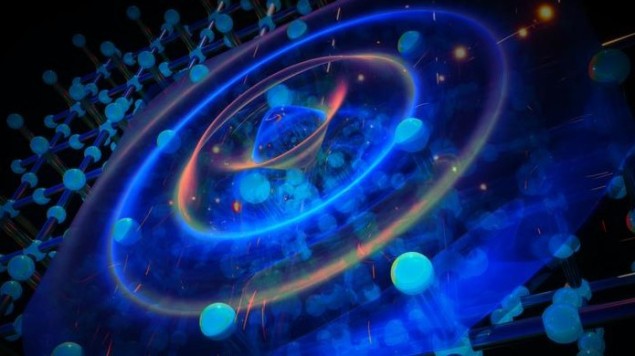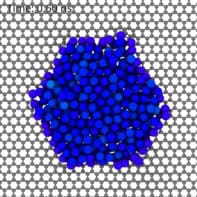
For nearly seven decades, a plasmon known as Pines’ demon has remained a purely hypothetical feature of solid-state systems. Massless, neutral and unable to interact with light, this unusual quasiparticle is reckoned to play a key role in certain superconductors and semimetals. Now scientists in the US and Japan say they have finally detected it while using specialized electron spectroscopy to study the material strontium ruthenate.
Plasmons were proposed by the physicists David Pines and David Bohm in 1952 as quanta of collective electron density fluctuations in a plasma. They are analogous to phonons, which are quanta of sound, but unlike phonons their frequency does not tend to zero when they have no momentum. That’s because finite energy is needed to overcome the Coulomb attraction between electrons and ions in a plasma in order to get oscillations going, which entails a finite oscillation frequency (at zero momentum).
Today, plasmons are routinely studied in metals and semiconductors, which have conduction electrons that behave like a plasma. Plasmons, phonons and other quantized fluctuations are called quasiparticles because they share properties with fundamental particles such as photons.
In 1956 Pines hypothesized the existence of a plasmon which, like sound, would require no initial burst of energy. He dubbed the new quasiparticle a demon in honour of James Clerk Maxwell’s famous thermodynamic demon. Pines’ demon forms when electrons in different bands of a metal move out of phase with one another such that they keep the overall charge static. In effect, a demon is the collective motion of neutral quasiparticles whose charge is screened by electrons from another band.
Experimental challenges
However, this long-standing prediction has been hard to confirm experimentally. With the two electron currents out of phase with one another, they cancel out and eliminate long-range Coulomb interactions. That precludes any signature from the demon in the metal’s dielectric properties, meaning that the quasiparticle does not interact with light.
Now, Peter Abbamonte of the University of Illinois Urbana-Champaign (UIUC) in the US, and colleagues have demonstrated how this difficulty can be overcome using a non-standard technique to study the metal strontium ruthenate. As they explain in a press release, they made their finding serendipitously. Rather than setting out to find Pines’ demon, they were instead exploring strontium ruthenate’s electronic properties in order to use the material as a kind of surrogate for high-temperature superconductors – which have similar properties.
The technique they used is known as electron energy-loss spectroscopy. This involves firing a beam of electrons with a well-known, narrow range of energies and recording how much energy is lost at which momenta after the electrons pass through a target material. The technique is well-suited to studying plasmons because electrons are very sensitive to fluctuations in charge density.
Using millimetre-sized single crystals of strontium ruthenate grown by Yoshiteru Maeno and co-workers at Kyoto University in Japan, the researchers recorded quite different spectra using low- and high-energy electrons. In the latter case they found energy loss peaking at around 1.2 eV, which they identify as an interaction with a typical (charged) plasmon. On the other hand, at lower energies they observed an oscillation with a tiny energy gap – less than 8 meV – at zero momentum.
Curious acoustic mode
This second feature, they say, is an acoustic mode with a velocity about 100 times that of sound, which is far too high to be associated with phonons. At the same time, however, the velocity of the mode is about three orders of magnitude lower than that of a surface plasmon. However, the figure is within 10% of that predicted by UIUC theorist Edwin Huang for a quasiparticle made up of two electron bands in strontium ruthenate oscillating out of phase with one another – a Pines’ demon.

New type of quasiparticle emerges to tame quantum computing errors
To make sure they really had found the demon, the researchers checked its neutrality by examining how its intensity varied with momentum — seen as variations in the electron scattering angle. They worked out that the intensity of a conventional plasmon should vary inversely with momentum raised to the power five. They say that the intensity of neutral plasmon should also vary inversely with momentum, but with a smaller power. That is what they found – establishing that the new quasiparticle was characterized by an inverse power of just 1.83.
“We conclude that this acoustic mode is Pines’ demon, predicted in 1956 but not observed in a 3D material until now,” they write in their paper announcing the result, which is published in Nature.
They argue that the demon could be better understood by carrying out additional experiments with a scanning transmission electron microscope and also by developing a hydrodynamic theory of the quasiparticle. But Abbamonte adds that such studies need not be limited to strontium ruthenate, explaining that the demon ought to be present in other metals with sufficiently different electron bands – including some superconductors, such as magnesium diboride or those based on iron. “It shouldn’t be a rare or esoteric effect,” he says.



